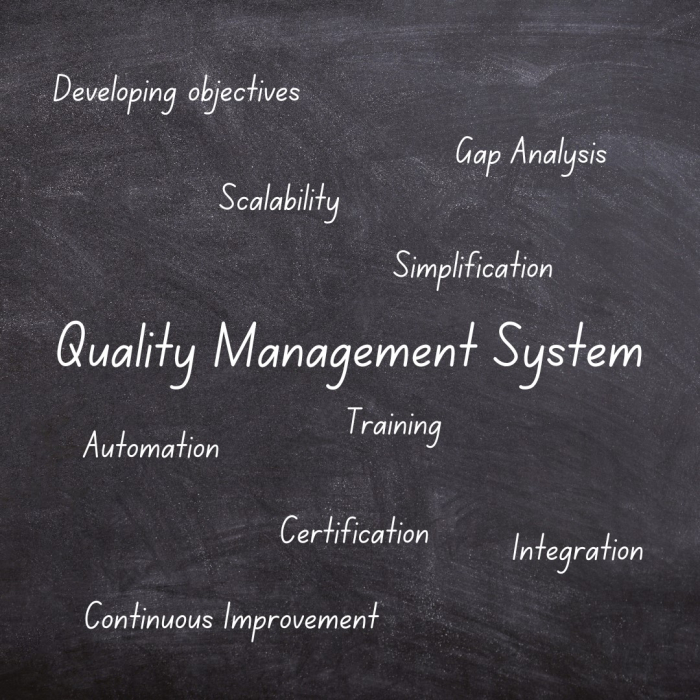
 Data Structure
Data Structure Networking
Networking RDBMS
RDBMS Operating System
Operating System Java
Java MS Excel
MS Excel iOS
iOS HTML
HTML CSS
CSS Android
Android Python
Python C Programming
C Programming C++
C++ C#
C# MongoDB
MongoDB MySQL
MySQL Javascript
Javascript PHP
PHP
- Selected Reading
- UPSC IAS Exams Notes
- Developer's Best Practices
- Questions and Answers
- Effective Resume Writing
- HR Interview Questions
- Computer Glossary
- Who is Who
10 Tips to Instantly Boost the Value of Your Quality Management System
Do you have a quality management system (QMS) in place but feel like it's not delivering the value you expect? Having a well-established QMS is essential for the success of any organization. In this article, we will discuss 10 easy tips to help you instantly boost the value of your quality management system.
What Is a Quality Management System (QMS)?
QMS is a formalized system that outlines the steps to take to carry out quality policies and objectives. An organization's activities can be better coordinated and directed with the use of a QMS, which also helps it continuously increase its effectiveness and efficiency while adhering to customer and regulatory standards.

10 Ways to Add Value to Your QMS
Simple steps can make a huge difference in the quality of your product and services. Here are 10 easy ways to increase the value of your QMS.
1. Define The Purpose of Your QMS
A QMS should have the dual goals of increasing customer happiness and developing a set of processes and procedures for delivering high-quality goods and services. It's critical to establish your QMS's purpose to make sure it serves its intended function. While defining the purpose of your QMS, you should consider the expectations of your customers. You must establish the processes in place to ensure quality and measure customer satisfaction. By defining the purpose of your QMS, you can ensure that it meets your customers' needs and helps you reach your business objectives.
2. Do A Gap Analysis
An effective approach for pinpointing areas of your quality management system (QMS) that require improvement is a gap analysis. You can do this by contrasting your existing QMS with industry norms or the QMSs of other businesses. It enables you to discover where your QMS might have gaps and to pinpoint variances between the two. You should take into account all facets of the QMS, such as its processes, procedures, documentation, and training while performing a gap analysis. After identifying the cracks, you must modify practices and procedures, introduce fresh technology, or develop extensive training courses to fill these gaps.
3. Create A QMS That Is Scalable
Scalability is important when creating a quality management system. An inflexible structure that won't change with you is the last thing you want. Utilizing templates and tools that can be readily modified and updated is the easiest way to build a scalable system. By doing this, you can make sure that your QMS is always in line with the scale and breadth of your operations as they are at the time. A clear future road map must be developed including checkpoints that outline how and when various system components will be updated, altered, or improved. Finally, it's critical to schedule time for regular testing, monitoring, and evaluation of your QMS. This will help you to spot any possible problems early on and make adjustments as necessary.
4. Simplify Your QMS
One of the best methods to raise the value of your quality management system (QMS) is to make it simpler. You must produce a condensed QMS that preserves only the crucial components and eliminates any complexity or duplication. After that, carefully go over each document and search for places where it might be streamlined. Ensuring each document has a logical structure and utilizing clear language are some examples of how to do this. It's critical to ensure that your documentation matches the most recent best practices and standards. You can raise the value of your QMS by taking the effort to simplify it, which will also increase its efficiency and minimize complexity.

5. Automate Where Possible
The QMS can be made to comply with both quality and compliance criteria by automating some procedures. It can shorten manufacturing cycles, increase productivity, and lessen manual errors. Automation software can be used to monitor adjustments and generate reports on QMS trends. Before integrating the automated processes into the system, make sure you thoroughly test them. This will help to guarantee their dependability and efficiency. It's also critical to think about how any automation technology you choose to use would affect data security. You may decrease manual work, save time, and increase the overall effectiveness of your QMS by automating when it is possible.
6. Integrate Your QMS
Your Quality Management System (QMS) must be integrated into your current processes and procedures to be effective. Not only would integrating your QMS into current operations assist to streamline quality management, but it will also raise the system's value. To make sure that all of your processes are interconnected and coordinated, you can link your QMS to your enterprise resource planning system. This will give you a uniform picture of your quality indicators and make it simple for you to monitor your progress. Finally, you can use the information from your QMS to build dashboards and reports to track success. By doing this, you can be sure that everyone has the knowledge they need to make the best choices for your business.
7. Train Your Employees
By providing training to your staff, you can be sure that everyone knows what their roles are within the system and how to correctly carry out the procedures. It is crucial to ensure that the training is adapted to the requirements of your particular QMS. For a thorough understanding of the system, you can think about combining classroom instruction, e-learning, on-the-job training, and practice exams. Maintaining employee awareness of the most recent QMS requirements is also crucial. Creating a routine for evaluating new policies and procedures and refresher training can keep everyone on the same page.
8. Communicate with Your Stakeholders
Even with a QMS in place, effective communication is essential to its success. A QMS's goals should be clearly stated, and you should make sure that all stakeholders are aware of their responsibilities. Additionally, discussing any QMS upgrades and modifications ensures that everyone is aware of the most recent version of the system. Using communication, you should also ask stakeholders for their opinions and thoughts. This provides a chance for development and ensures that everyone is on board with the system. Keeping your stakeholders informed can help your QMS operate more efficiently and add to its total value.
9. Get Certified
Obtaining certification gives independent third-party validation of your processes and shows that you are adhering to industry standards and best practices for quality control. Look for a certification program that is customized to your company and satisfies the requirements of your stakeholders and consumers. You must establish a quality management system (QMS) that satisfies all of the requirements specified by the certifying authority to become certified. You may show clients and stakeholders that you are committed to offering high-quality goods and services by acquiring certification for your QMS. Additionally, having a certified QMS can increase productivity and cut expenses because all processes will be standardized and recorded, facilitating quicker problem-solving.
10. Continuously Improve
The success of quality management systems depends on continuous improvement. This can be accomplished by using a PDSA cycle, which enables you to spot areas for improvement, make the necessary adjustments, and then evaluate the results. You must put a lot of effort into areas like cost-cutting, bettering customer service, raising customer happiness, and optimizing procedures if you want to make sure your QMS is constantly becoming better. You may learn more about how people feel about your product or service and pinpoint areas that require improvement by asking employees and consumers for feedback.
Conclusion
Any organization's growth depends on having a solid QMS in place. By continuously striving to improve your QMS, you can increase its value and ensure it meets the needs of both customers and your business.

